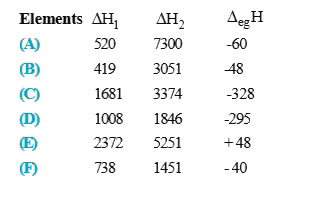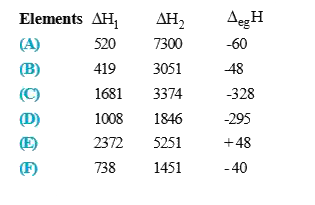Match the correct ionisation enthalpies and electron gain enthalpies of the following elements
ElementsΔH1ΔH2ΔegH(i)Most reactive non metalA.4193051−48(ii)Most reactive metalB.16813374−328(iii)Least reactive element C.7381451−40(iv)Metal forming binary halide D.23725251+48
(i) Most reactive and non- metals has high ΔiH and ΔiH2 and most negative Δeg H. Therefore the element is B (ii) Most reactive metals has low ΔiH and high ΔiH2 (because the 2nd electron has to be lst from noble gas configuration ) and has small negative ΔegH. There fore the element is A.
(iii) Noble gases are the least reactive elements . they have very high ΔiH1 and ΔiH2 and have positive ΔegH values. Thus the element is D.
(iv) Metals formning binary halides are alkaline earth metals . They have ΔiH1 and ΔiH2 values little higher than those of most reactive metals (such As A) and have compariatively slightly less negative ΔegH values thus, the element is C .
From the above the discussion the correct matching is as follows :
(i)→B,(ii)→A,(iii)→D and (iv) →C
Topper's Solved these Questions
- CLASSIFICATION OF ELEMENTS AND PERIODICITY IN PROPERTIES BOOK - PRADEEPCHAPTER - CLASSIFICATION OF ELEMENTS AND PERIODICITY IN PROPERTIES EXERCISE - NCERT (EXEMPLAR PROBLEMS) (Assertion and Reason type question )
3 Videos
- CLASSIFICATION OF ELEMENTS AND PERIODICITY IN PROPERTIES BOOK - PRADEEPCHAPTER - CLASSIFICATION OF ELEMENTS AND PERIODICITY IN PROPERTIES EXERCISE - NCERT (EXEMPLAR PROBLEMS) (Long Answer Questions )
6 Videos
- CLASSIFICATION OF ELEMENTS AND PERIODICITY IN PROPERTIES BOOK - PRADEEPCHAPTER - CLASSIFICATION OF ELEMENTS AND PERIODICITY IN PROPERTIES EXERCISE - NCERT (EXEMPLAR PROBLEMS) (SHORT ANSWER QUESTIONS)
18 Videos
- CHEMICAL BONDING AND MOLECULAR STRUCTUREBOOK - PRADEEPCHAPTER - CHEMICAL BONDING AND MOLECULAR STRUCTUREEXERCISE - Curiosity Questions
2 Videos
- ENVIRONMENTAL CHEMISTRYBOOK - PRADEEPCHAPTER - ENVIRONMENTAL CHEMISTRYEXERCISE - COMPETITION FOCUS (JEE(Main and Advanced)/Medical Entrance (VI.ASSERTION-REASON) Type II
6 Videos
Similar Questions
The first and second ionization enthalpies and electron gain enthalpy of some elements are as given below:

Which of these elements is the most reactive metal?
View SolutionThe first and second ionization enthalpies and electron gain enthalpy of some elements are as given below:

Which of these elements is the least reactive non-metal?
View Solution
Knowledge Check
The first and second ionization enthalpies and electron gain enthalpy of some elements are as given below:

Which of these elements is the most reactive metal?A(A)B(B)C(F)D(D)The first and second ionization enthalpies and electron gain enthalpy of some elements are as given below:

Which of these elements is the least reactive non-metal?A(C)B(D)C(E)D(F)The first and second ionization enthalpies and electron gain enthalpy of some elements are as given below:

Which of these elements is the most reactive non-metal?A(C)B(D)C(E)D(F)
The first and second ionization enthalpies and electron gain enthalpy of some elements are as given below:

Which of these elements is the most reactive non-metal?
View SolutionThe first (ΔiH1) and second (ΔiH2) ionisation enthalpies (inkJmol−1) and the (ΔegHө) electron gain enthalpy (inkJmol−1) of a few elements are given below:
Elements(ΔiH1)(ΔiH2)ΔegHөI5207300−60II4193051−48III16813374−328IV10081846−295V23725251+48VI7381451−40
Which of the above elements is likely to be
a. the least reactive element.
b. the most reactive metal.
c. the most reactive non-metal.
d. the least reactive non-metal.
e. the metal which can form a stable binary halide of the formula MX2 (X=halogen).
f. the metal which can form a predominantly stable covalent halide of the formula MX(X=halogen).
View SolutionThe first (ΔiH1) and second (ΔiH2) ionisation enthalpies (inkJmol−1) and the (ΔegHө) electron gain enthalpy (inkJmol−1) of a few elements are given below:
Elements(ΔiH1)(ΔiH2)ΔegHөI5207300−60II4193051−48III16813374−328IV10081846−295V23725251+48VI7381451−40
Which of the above elements is likely to be
a. the least reactive element.
b. the most reactive metal.
c. the most reactive non-metal.
d. the least reactive non-metal.
e. the metal which can form a stable binary halide of the formula MX2 (X=halogen).
f. the metal which can form a predominantly stable covalent halide of the formula MX(X=halogen).
View SolutionThe first (ΔiH1) and second (ΔiH2) ionisation enthalpies (inkJmol−1) and the (ΔegHө) electron gain enthalpy (inkJmol−1) of a few elements are given below:
Elements(ΔiH1)(ΔiH2)ΔegHөI5207300−60II4193051−48III16813374−328IV10081846−295V23725251+48VI7381451−40
Which of the above elements is likely to be
a. the least reactive element.
b. the most reactive metal.
c. the most reactive non-metal.
d. the least reactive non-metal.
e. the metal which can form a stable binary halide of the formula MX (X=halogen).
f. the metal which can form a predominantly stable covalent halide of the formula MX(X=halogen).
View SolutionElementΔiHΘ1ΔiHΘ2ΔegH01I16813374−328II10081846−295III23725251+48
(a) The most reactive non-metal.
(b) The least reactive non-metal.
(c) The least reactive element. Give reasons also.
View Solution
